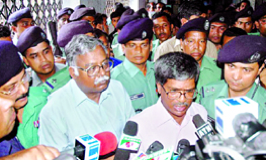Masculinity, Public Memory and Censorship
By Rahnuma Ahmed
Because it can be neither forgotten nor redeemed, the past must be changed. To redeem the past one must alter one’s relationship to it… If the problem.. [is that] of a one-dimensional political representation, then what it calls for is not work on the subject — or not just that — but… “political work on the symbolic.”
Linda M. G. Zerilli, The Abyss of Freedom.
Bissrinkhol Drissho: Pourush, Public Smriti O Censorship attempts to do that. To politically work on that which is symbolic. It came out recently, as a small booklet. My article is prefaced by a foreword written by Abdullah al-Mamun, who teaches Mass Communication and Journalism at Rajshahi University. He was released from prison nearly six weeks ago, alongwith three other teachers, Moloy Kumar Bhowmik, Dulal Chandra Biswas and Selim Reza Newton. They were granted presidential clemency on 10 December 2007. Incidentally, neither the teachers, nor their wives, had appealed for a presidential pardon.
They have been released from prison, but not from the farce that the government is carrying out with public university teachers, students and employees. The clemency covers conviction and punishment, but the government has not withdrawn the case against them. Mamun and the others appear in court on January 28, when appeal hearings begin.
The newly-appointed education advisor while talking to news reporters about the case against Dhaka university teachers, unwittingly exposed the farce. “Whatever be the verdict,” he said in all seriousness, the teachers will be “released soon.”
Whatever be this week’s outcome, these famous last lines will not be easily forgotten.
Not a straight-forward affair
Photographs. And people. The connection is not a simple one. `Hey, I didn’t know you had gone to Rajendrapur?’ `Just that once, the picnic was terrible.’ Photographs capture a particular moment, but to know whether that moment is something out of the ordinary, whether it represents a whim or a regular habit, we need people. We need testimony. Thus, what a photograph can tell us has its limits. Documentary photographs, at times, may not give us the feeling of recognition we expect, “Is that you? I would never have guessed.” Sometimes they may be pretty inaccurate. Also, there is the question of interpretation. “Hmm, looks like the two of you had snuggled up real close…” “No, no it’s the angle, he was at least five feet away.” As I said, the connection between people and photographs is not a straightforward affair.
Mishaps may happen. Ordinary people may feel piqued on seeing the results, “The light wasn’t good” or, “She’s a lousy photographer,” but rulers are less likely to take them kindly. Specially, if it unravels carefully-constructed identities. Group identities of patriotism and disinterested professionalism. Identities crucial to legitimising. Identities essential for individual ambitions.
Censorship is often thought of stereotypically. As a prohibition, a ban on disclosure. Mamoon, in his foreword to Bissrinkhol Drissho (henceforth Unruly Images) argues differently. He writes, censorship is relational. It is oppositional. Desired images, destined for circulation, are continuously produced and re-produced while undesirable ones are stifled. Both occur simultaneously to construct a reality that meets the expectations of rulers.
Dhaka University incident: unruly images
Unruly Images is about the regime of visual images, not flesh-and-blood people. In it I take a close look at two photographs generated during the Dhaka University protests of August 2007. The military-backed caretaker government came to power in January 2007. Soon after, a perceptible change took place in the world of visual representations, in the world of images. Military masculinity came to be foregrounded as a distinct form of masculinity, in opposition to civilian masculinity, its silent other. TV, both government and private channels, and the print media were the primary instruments used to effect the change. The act of foregrounding re-drew the difference between civilian and military as a primary one, something qualitatively different to the multiplicity of competing masculine images, leader, cadre, executive, mastan, businesman etc seen during the period of elected governments, 1990-2007. In military song video performances regularly screened on TV, military masculinity is portrayed as infinitely courageous, whether on the training ground, in the battle for liberation, or soldiering for peace in faraway lands. The army uniform emerges as a symbol of discipline, regularity, order, control, restraint, punctuality. In writing this, my concern is not with its truth, it is solely with images, with portraiture. The song-video images lack social depth. There are no folds, no seams, no hesitancies, and as such, they are propagandistic. Being fragile, they are unable to withstand the realities of life. They falter if not propped up by the state. Their fragility grieves the creators, their grief and pain is expressed in language founded on the state’s powers of coercion. As happened in the case of Dhaka University, in August 2007.
The publication of the first photograph, the censored one, created disorder in the world of images. To restore order, it became necessary to introduce the second image, Professor Anwar Hossain’s apology to the armed forces. This image was generously circulated, distributed and re-distributed, over and over again. The times however were tumultuous, one event rapidly followed the other. That the two photographs are linked, in a cause-and-effect fashion, was something overlooked. Looking at one image brings back memories of the other. It was an oversight. Such things do happen, even with the best of intentions.


If the first image is censored, how does one talk about it? How do I convey to readers what is in the photograph? How does one manoeuver around censorship restrictions?
Three sources exist, highly reliable sources, not-censored sources, that offer us a language to talk about them. One is Professor Anwar Hossain’s statement itself, a primary text, an authentic one since those to whom it is addressed have not raised any objections. Of the other two sources, one is to be found on the Bangladesh armed forces website (Dhaka Bisshobiddaloyer Shongothito Opritikor Ghotonatir Itikotha); the other is also military, but un-official http://www.bdmilitary.com/.
In Professor Anwar Hossain’s statement, one comes across the lines of opposition: army/military versus civilian. Civilian is expressed through different words, “students,” “Dhaka university,” “teacher,” “General Secretary of Dhaka University Teachers Association” ” guardian of the students.” These words give us an idea of place, time, the actors involved. A happening seems to have occurred, one that involves action and reaction. Professor Anwar mentions the word “attack” five times. I assume, from the logic of the apology offered, that a student has attacked a member of the army. The nature of the attack? The title of a BMF report found on its website indicates an unarmed attack, The “Flying Kicker” Identified (for those who don’t know, Bangladesh Military Forces Group is an independent, non-governmental, non-political and non-profit association of research on defence and strategic issues). “The” and “Kicker,” are telltale words that indicate one student, not many. Other words indicate one army member only, “an attack on a member of the army means an attack on the armed forces, as a whole”. He must have been in uniform, or else why would Professor Hossain say, “The agitated students even attacked [members of the] army in uniform” “If anyone attacks the uniform of a member of the army…”
I find the elision between “uniform”, “a member of the army”, and “the army as a whole” in Professor Hossain’s statement, and in the other sources, breathtaking. The elision is re-inforced in the mapping-out of the army: from the ordinary jawan at the lower rungs, to the army chief at the top. Map the text on to the image and one gets frightening results, a student becomes representative of Dhaka University as a whole, of the civilian sector as a whole. A hapless member of the army becomes representative of the army as a whole, of its honour and respect. In the process, a particular meaning gets attached to the army — the lack of courage. Images of valour and courage present in the war of liberation in 1971, in UN peacekeeping missions abroad, recede.
Why were the words that spoke of the students’ self-respect, the ordinary peoples self-respect censored? Why was Professor Anwar allowed to make a statement to the press? After all, he was in remand (allegations of physical and mental torture). Why was the elision permitted? It only serves to fracture national unity on civilian vs miltary lines.
The events at Dhaka university speak of a story of humiliation. Of revenge. Of arrogance and ill-conceived strategies. Of unintended consequences.

Did you notice the implication of what you wrote? All major violations of the law by ordinary citizens – tax evasion, ticketles travel, protests, and the like are vis a vis the state. Minor violations like your riding the bicycle or the rickshaw on a car lane, merely inconvenience us. As long as these rules do not serve to fulfil the basic needs of the ordinary person, as long as the state is perceived not to respond to people’s aspirations or reflect their ethos, then these violations are the norm. We need a responsive state. when we have one, violation of the law (i do not include heinous crimes here, merely breaking the law or bending it) will reduce in numbers. RR